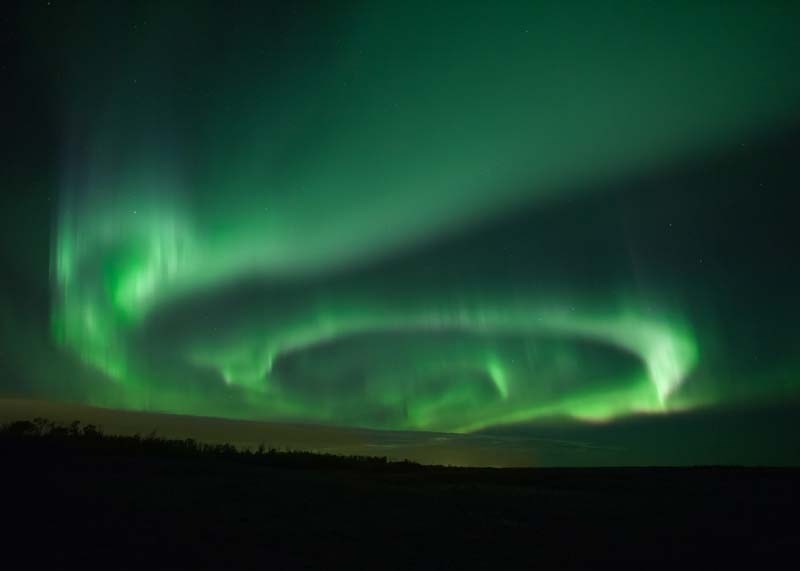Visitors to our parts from elsewhere in Canada may be aware of the aurora borealis, commonly called northern lights – after all, we often claim them as our own in this country – but for those from further afield, the swirling ribbons of pale greens and pink hues dancing in the night sky can be a magical mystery.
In truth, the lights are a bit of a mystery to me too. As a born and raised prairie girl, I've been seeking the aurora all my life. About 30 years ago, I made the 35-hour train trip from Winnipeg to see the polar bears in Churchill, Man., sure that I'd also get a wonderful show from the northern lights. It was cloudy the entire time – no lights for me. And in the more than 10 years that I've lived this far north in Alberta, I've seen the lights once or twice – that's it. But with these tips and tools, I'm confident my luck will change.
Here then is a primer – an aurora borealis 101 – on the what, when and where to see this spectacular light display. Simply, aurora are the result of solar activity – electrically-charged particles from the sun entering the earth's atmosphere. The milky or cloudy patches we see can take many forms, from rippling curtains to slow-moving swirls, and are best seen above the magnetic poles of the northern and southern hemispheres.
Dr. Ian Mann, founder of the popular website Aurora Watch at the University of Alberta, says that at 53 degrees latitude, Edmonton's capital region is one of the best places in the world to see the northern lights. Other good spots include much of northwestern Canada, the Yukon, Nunavut and Alaska.
"Aurora are best seen in a clear winter sky, outside the city, but I've seen great displays in town too – dancing arcs that ripple up," Mann said. "And we're in a period of maximum solar activity right now – the end of an 11-year cycle – so this year is an ideal time to catch them."
The Aurorawatch.com website has a plethora of information on all things aurora, and subscribers to the free service will even get alerts in their e-mail inbox when aurora are likely to appear in our skies. It's a tool well-used by curious onlookers and professionals who make a living finding and photographing the northern lights whenever they appear.
Unpredictable
Edmonton photographer Zoltan Kenwell has been shooting Alberta nightscapes, and the aurora in particular, for several years. He says that, with 270 days of clear skies each year, our northern climes provide a great opportunity to catch a glimpse of the solar-charged particles that can look almost neon in nature, in hues of purple, blue and the most common, green.
"It's hard to predict when and where to spot aurora – it's kind of like waves on a beach – but the Internet is a great tool for studying wind direction and solar activity," he said.
From September through late March – January and February are the best – Kenwell said he hunts for aurora on clear nights between midnight and 6 a.m., and most often 30 kilometres outside the city, away from the light pollution that clutters the view.
Kenwell's photos of the northern lights have been used by NASA and tourism websites around the world. You can see his work at infocusimagery.com.
Joel Koop loves to take photos of the northern lights. The 33-year-old employee of McBain Camera in St. Albert Centre is trained as a graphic designer, but has taught himself to shoot landscapes, especially the aurora, at several places around St. Albert.
"Since clouds and city lights can prevent seeing or photographing the aurora, I recommend heading north of the city. I also like Elk Island, just a half-hour away, because it's a dark sky preserve, where lights are limited," said Koop.
For those who want to see and snap the lights, starting with figuring out how to handle their SLR (single lens reflex) camera, Koop offers a one-day, six-hour class called Mastering Your SLR. The $150 course focuses on shutter speed, aperture and iso, teaching students to create compelling images regardless of the subject.
For night shooting of aurora borealis, Koop suggests using a tripod and a long shutter speed (about 20 seconds) to allow in as much light as possible.
While a class or membership with the local photo club gives aficionados an outlet for snapping the dancing lights, what of novice watchers, looking for the northern lights in the backyard? Kenwell says big solar events – easily visible in the city – can happen anytime, so if it's a clear winter night, crane your neck skyward.
"If it's a spectacular display, even smartphones can capture the event. And the average person using a cheaper digital SLR can take good photos in the backyard too," Kenwell said. "Pay attention to the skies when you're out on a winter night, and don't forget your camera!"




